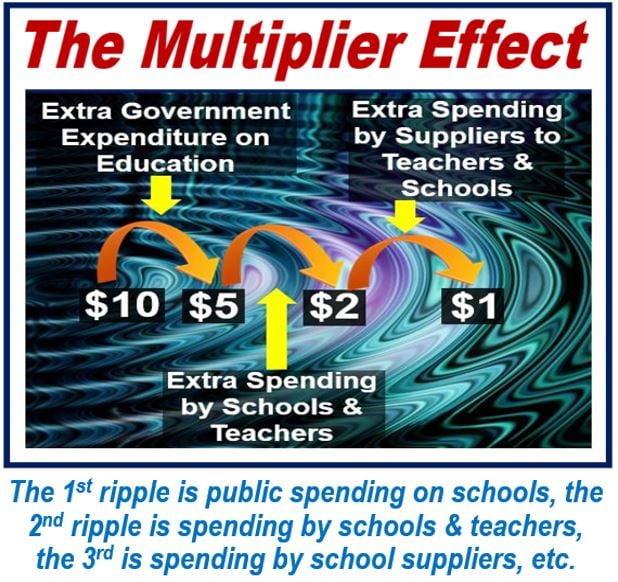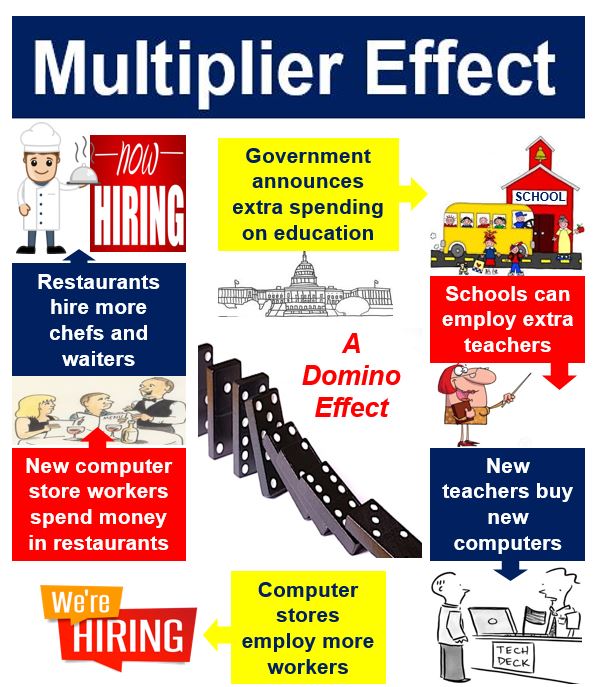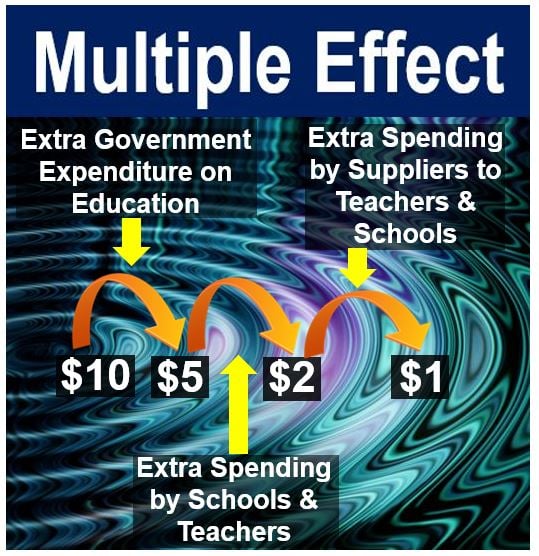A Multiplier or the Multiplier Effect is the factor by which the return resulting from an expenditure is greater than the expenditure itself, or the way in which a change in spending leads to an even bigger change in income. The term is generally used in reference to how much a certain amount of expenditure increases total national income or GDP (gross domestic product).
Moreover, the multiplier effect is not uniform across different sectors; for instance, spending on infrastructure or technology may have a higher multiplier effect compared to other types of government expenditure
Example of the multiplier effect – education
Imagine that the government spends an extra $5 billion on education. The immediate effect is an increase in teachers’ income as well as greater sales of goods and services for companies that supply schools.
These people and businesses will in turn spend their extra income, making other entities richer, who spend some of that money, etc.

As far as the theory goes, this process should go on and on forever, in which case the multiplier has an infinite value. Most people and entities who become richer as a result of the initial expenditure put some of that money into savings rather than spending it.
How much of their extra income is spent depends on their marginal propensity to consume. The multiplier’s value can be calculated by using the following formula:
Muliplier = 1 ÷ (1 – marginal propensity to consume)
If the marginal propensity to consume are 0.25 or 0.50, the multipliers are 1.33 and 2 respectively.

When talking about the amount of money that a bank can generate for each dollar of reserves, we use the term ‘money multiplier’. When discussing government spending, and how that initial extra expenditure can create additional wealth, we use the term ‘fiscal multiplier’.
The multiplier and John Maynard Keynes
British economist John Maynard Keynes, whose ideas fundamentally changed the theory and practice of macroeconomics and governments’ economic policies, created the multiplier theory and its equations.
Keynes said that an increase in government spending created a proportional boost to overall income or GDP, because the additional spending would have a ripple effect through the economy.
Keynes first mentioned this effect at the height of the Great Depression in 1933 in his book – The Means to Prosperity. While addressed mainly to the British Government, his work also contained suggestions for several other countries that were also affected by the Great Depression.
US President Franklin D. Roosevelt and other world leaders received a copy. The British and US governments took the work seriously. This paved the way for the later general acceptance of Keynesian ideas.
According to Keynes, with a multiplier of two, the economy grows by $2 while the government deficit increases by $1.
Scores of papers written by economists have attempted to estimate fiscal multipliers since the global financial crisis of 2007/8 and the Great Recession that followed. The International Monetary Fund (IMF) calculated that the ‘harmful’ economic multiplier for fiscal contractions was often at least 1.5.
The Economist made the following comment regarding governments’ recent fiscal stimulus:
“Even as many policymakers remain committed to fiscal consolidation, plenty of economists now argue that insufficient fiscal stimulus has been among the biggest failures of the post-crisis era. Decades after its conception, Keynes’s multiplier is relevant, controversial and ascendent.”
Tourism and the multiplier effect
The multiplier effect from tourism is relatively high, due to several factors:
-
Diverse spending
Tourists spend money on food, drinks, tours, souvenirs, entertainment, taxis and other transportation, and general shopping. This diverse spending supports various businesses and sectors within the economy.
-
New jobs
Tourism typically creates jobs both directly and indirectly. Waiters, chambermaids, and airport staff are examples of direct employment, while shop assistants, taxi drivers, and those working in food production and distribution are examples of indirect employment.
-
Stimulating local economies
In regions where tourists are major contributors to the overall economy, tourism can be particularly impactful. Florida, the South of France, and many parts of Spain became prosperous partly thanks to tourism.
-
Seasonal boost
In some parts of the world, the influx of tourists can provide a major economic boost during certain times of the year. In many cases, these boosts help sustain year-round operations, i.e., permanent jobs.
-
Promotion of Related Industries
Industries involved in the creation of infrastructure, such as construction companies benefit significantly from tourism.
-
Foreign Exchange Earnings
In Mexico, for example, tourism is an enormous earner of foreign exchange, especially US dollars. Foreign exchange earnings help maintain a positive balance of payments.
The extent of tourism’s multiplier effect may vary depending on what type of tourism a country or area receives (e.g., luxury vs. budget) and how much of the money that tourists spend remains locally versus going to foreign-owned entities.
Becoming over-reliant on tourism is risky, as the COVID-19 pandemic revealed. The economies of countries like Thailand, Spain, and the Maldives, which depend heavily on tourism, suffered significantly during the pandemic.
Video – What is the multiplier effect?
This interesting video presentation, from our YouTube partner channel – Marketing Business Network, explains what the ‘Multiplier Effect’ is using simple and easy-to-understand language and examples.

